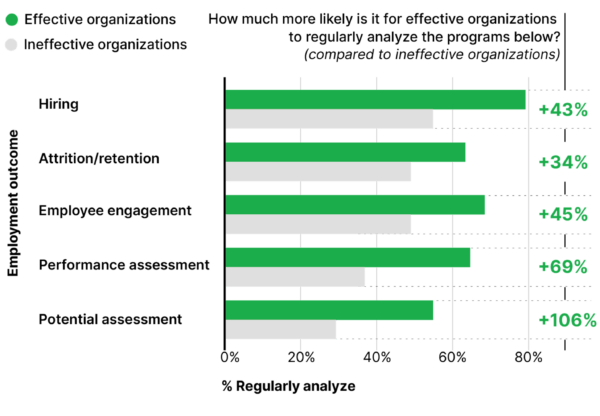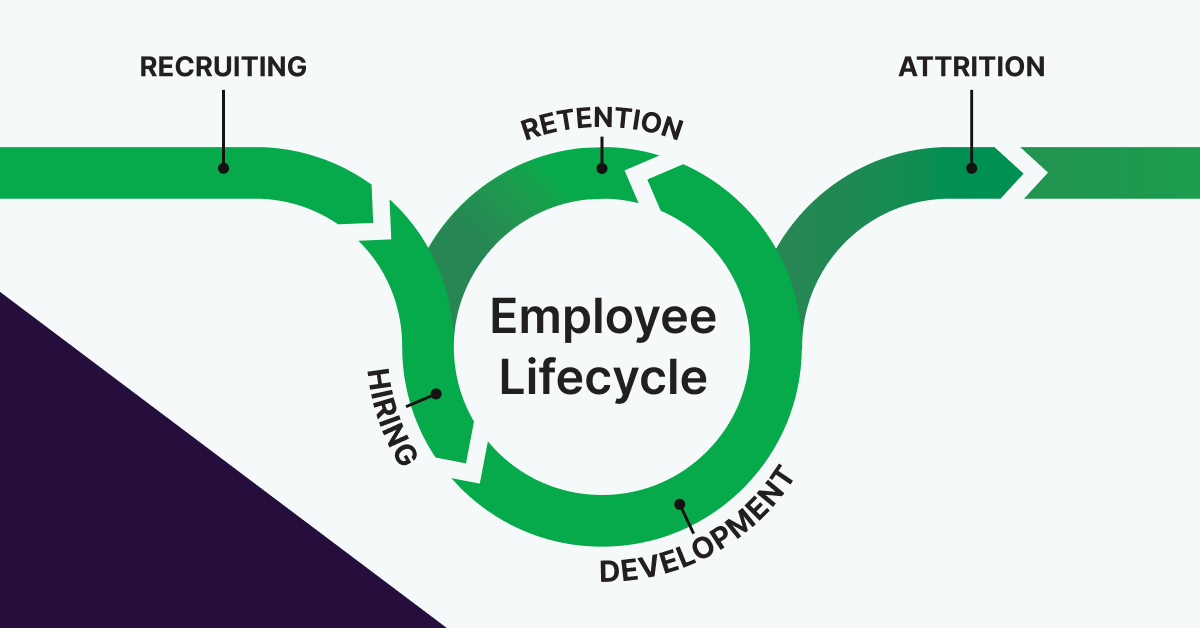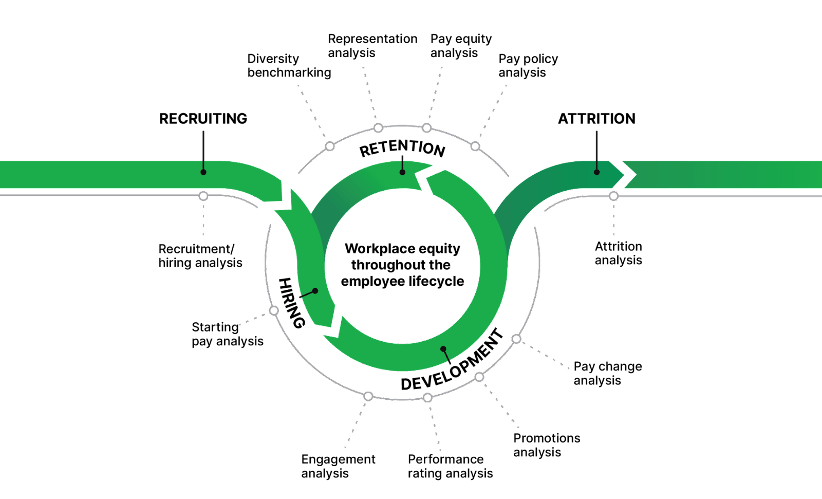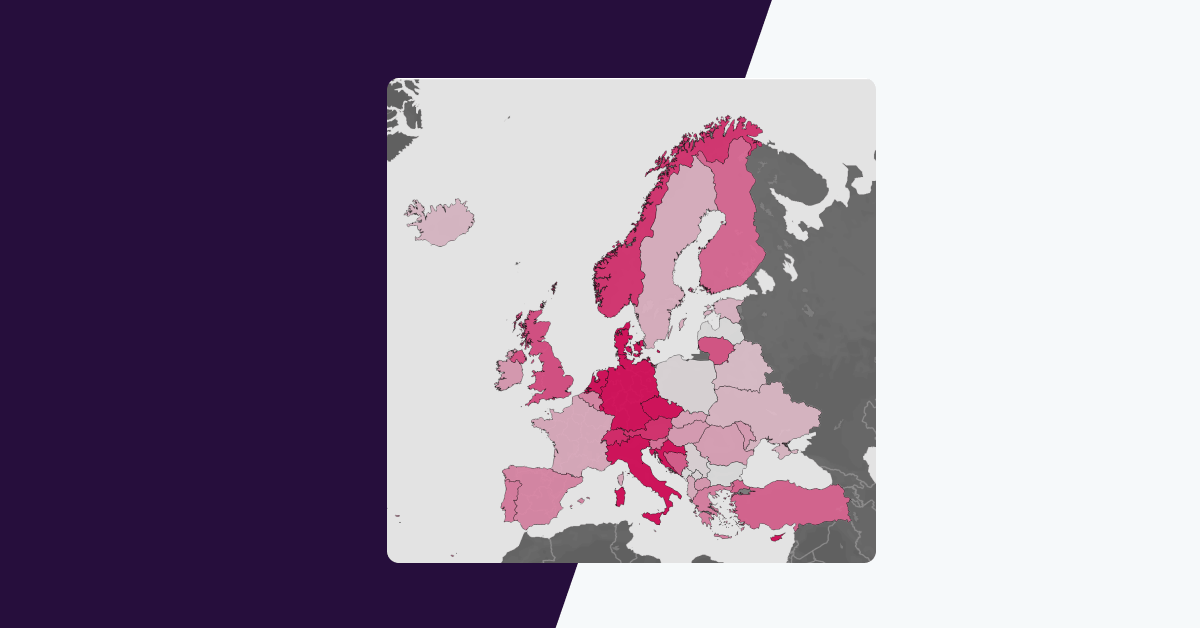Inequities seldom exist in isolation in the employee lifecycle — rather, they are highly interconnected. For example, unfair pay alone fails to fully account for the pay gap, which also results from inequitable opportunities for career advancement and disproportional representation in high-paying management and leadership roles. This means that for companies committed to closing their pay gaps, a narrow focus on compensation alone will fall short.
Workplace equity programs therefore need to be holistic and cross-functional, identifying and tracking connections between multiple employment outcomes. To build truly equitable workplaces, companies must broaden their analyses beyond pay to assess critical junctures in the employee lifecycle, including: hiring outcomes, performance and potential assessments, engagement, and attrition.
Below, we dissect workplace equity throughout the entire employee experience and share different types of analyses companies can undertake to ensure they are effectively addressing systemic inequities.
Analyzing workplace equity throughout the employee lifecycle
“The list of interdependencies is very long for workplace equity work. If you update one piece, it has upstream and downstream impacts.”
– Survey respondent for the 2024 Workplace Equity Report
Workplace equity means unlocking the full potential of every employee by dismantling artificial barriers and treating them without bias. However, inequities rarely confine themselves to a specific moment in the employee experience. Disparities introduced in one area can have consequences later.
For example, if performance reviews are marred by bias, then resulting promotions may be inequitable, which can lead to disproportionate leadership representation down the road. Similarly, if the workplace culture doesn’t foster inclusivity and belonging, retention rates may be inequitable, which can also set back representation of specific employee groups.
The tangible implications of this interconnectedness are evident in research findings. A study from Alan Benson, Danielle Li, and Kelly Shue found that, despite receiving higher performance ratings than men on average, women received lower potential ratings than men — resulted in women being 13% less likely to be promoted than men. In this case, inequitable potential ratings lead to a gender promotion gap, which in turn could likely contribute to an organization’s gender pay gap.
Dive deeper into 8 types of workplace equity analysis >
Therefore, to take a more preventive stance on inequity, you need to assess equity at each step of the employee lifecycle so that you can create a targeted, data-driven action plan for interventions. The 2024 Workplace Equity Trends Report found that organizations that effectively build diverse teams regularly conduct more analyses for group-based impacts, including: hiring, attrition / retention, employee engagement, hiring outcomes, performance assessments, and potential ratings.

1. Recruiting and hiring
Analyzing recruitment and hiring involves tracking applicant demographics throughout the hiring funnel to assess the likelihood of different demographic groups progressing from applicants to job offers. This analysis helps organizations gauge whether their recruitment and hiring practices are attracting a diverse pool of candidates and whether candidates are progressing through the pipeline equitably.
A recruitment/hiring analysis helps pinpoint where candidates of specific demographics may be disproportionately dropping out during the hiring process, allowing you to flag problem areas. Is the applicant pool not diverse enough, or are there biases in job descriptions? Could the interview process introduce bias? Do certain groups only make it to the manager screening and not progress to the full interview, or do they get interviewed but not offered the position? Identifying and addressing these potential barriers to entry is crucial for fostering a fair and inclusive hiring process.
A starting pay analysis is important to ensure that new hire pay decisions do not negatively impact pay equity. Learn how Elevance Health leverages Syndio’s Pay Finder solution to help hiring managers and recruiters deliver competitive offers that maintain equitable pay for every new hire.
2. Compensation
A pay equity analysis entails identifying compensation patterns based on employee identity to ensure that employees are being compensated fairly and equitably for similar work, irrespective of identity factors. The key steps for a pay equity analysis involve grouping employees performing similar work, controlling for legitimate job-related factors that explain differences in pay, testing for identity-based differences in pay after applying those controls, and addressing any remaining gaps through targeted pay adjustments. A comprehensive pay equity analysis considers both race/ethnicity and gender, as well as the intersections of each. Syndio’s leading pay equity software, PayEQ®, makes it easy to analyze, resolve, and prevent pay disparities due to gender, race, or other factors.
A pay policy analysis identifies whether your stated pay policies — which may incorporate elements such as tenure, experience, location, or performance scores — are being applied effectively and consistently in practice. Syndio’s Pay Policy Analytics tool in PayEQ quantifies how much each pay policy impacts pay overall and by group, and helps identify hidden or unintentional drivers of pay differences (like gender or race).
3. Career development and promotions
An engagement analysis involves identifying differences in employee engagement or satisfaction rates across identity groups. At the most basic level, this includes calculating whether any particular group is more or less likely to assign the company the average engagement and/or satisfaction score. This analysis helps organizations understand whether specific groups of employees are feeling disengaged or unsupported, which can stem from a lack of inclusion and belonging in the workplace.
Engagement analysis can take various forms. Rather than solely examining overall engagement outcomes by communities, engagement surveys can delve into specific aspects of diversity, inclusion, and belonging. An organizational network analysis can identify connections between employees, providing a look at how communities are (or are not) integrated into the organization.
A performance rating analysis entails examining differences in performance ratings by employee identity group to understand whether each group is more or less likely to receive receive positive — or negative — performance reviews. This analysis helps uncover whether certain groups of employees are being unfairly rated or undervalued due to inequitable performance rating processes so that the organization can address discrepancies. A recent Syndio study found that 1 in 4 employees feel their performance reviews were negatively affected by their supervisor’s personal biases. Given that performance data heavily influences decisions regarding promotions, raises, and even layoffs or terminations, identifying and addressing bias at this stage is pivotal in preventing its impact on other facets of the employee lifecycle.
A promotions analysis examines whether specific identity groups are more or less likely to receive promotions compared to the average promotion rate within the company. This analysis helps organizations gauge whether certain groups of employees are being unfairly passed over for promotions or not given equitable opportunities for advancement. By using analytics to understand if they have inequitable promotion rates, companies can then dig into possible underlying causes such as inequitable ‘potential’ ratings or unequal access to projects and opportunities — then identify strategies to mitigate them. The Promotions analysis tool in Syndio’s OppEQ® helps uncover inequities in promotions and creates accountability for providing equitable access to career opportunities.
A pay change analysis is important to ensure that pay changes, such as raises related to promotions, maintain pay equity. Syndio’s Pay Finder solution was designed to help organizations maintain fair pay with every pay decision.
4. Representation
A representation analysis involves examining demographic trends among employees based on job type, level, or department. For example, an organization might analyze the ratio of men to women in engineering roles or the ratio of white employees to BIPOC employees in executive roles. Inequitable representation, particularly higher-paying management and leadership roles, can be a major contributor to companies’ median pay gaps. A representation analysis is crucial to gain insight into the current composition of your workforce so that you have a baseline for measuring progress towards diversity goals.
Diversity benchmarking involves comparing internal demographic data to external sources such as U.S. Census or EEO-1 data. By benchmarking your employee population against both internal talent availability and external labor pool data, organizations can pinpoint gaps in their current composition compared to what’s available for their industry and labor pool. This enables organizations to set realistic, data-backed representation targets for departments and levels. Syndio’s OppEQ measures your current demographic makeup, benchmarks against available talent, helps you develop meaningful representation goals, and forecasts when you’ll meet them.
5. Retention/attrition
An attrition analysis involves identifying differences in attrition rates by employee identity group to determine whether a specific group is more or less likely to leave than the company’s average attrition rate. Inequitable attrition rates contribute to organizations’ pay gaps by creating a “leaky bucket” in which women and people of color exit at disproportionately higher rates — meaning that they don’t remain in or progress into higher paying roles. Companies that uncover inequitable attrition rates can then work to identify root causes, such as lack of inclusion and belonging or inequitable career opportunities.
Data helps you “peel back the onion” to know where to target efforts
“Maybe you start with a pay equity analysis and then realize that you still have a pay gap. That might lead you to want to analyze your representation. Then maybe that analysis is going to highlight a lack of women in leadership roles, which is going to lead you to analyze whether women have equitable access to opportunities to be promoted into those more senior positions. So we can keep peeling back this onion to give us a more holistic view into where you can target your efforts to realize improvements.”
– Vanessa Lynskey, Principal Product Manager at Syndio during The Workplace Equity Program of the Future webinar
Every point in the employee lifecycle presents an opportunity for ensuring equitable treatment. But to do so requires analytics to understand where disparities exist so that you can triage targeted interventions. Syndio’s Workplace Equity Analytics Platform is designed to provide organizations with a holistic view of workplace equity throughout the employee lifecycle. Organizations can easily analyze pay decisions, hiring, promotions, and performance scores by gender, race, and more to identify the root causes of opportunity and pay gaps — and create action plans for improvement.
Read the 2024 Workplace Equity Trends Report and watch The Workplace Equity Program of the Future webinar to learn more about how leading companies are taking a proactive, holistic approach to workplace equity.
The information provided herein does not, and is not intended to, constitute legal advice. All information, content, and materials are provided for general informational purposes only. The links to third-party or government websites are offered for the convenience of the reader; Syndio is not responsible for the contents on linked pages.



